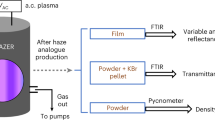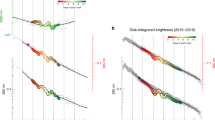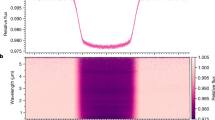Abstract
Investigating the overall brightness of planets (and moons) provides insights into their envelopes and energy budgets1–4. Phase curves (a representation of the overall brightness versus the Sun–object–observer phase angle) for Titan have been published over a limited range of phase angles and spectral passbands5,6. Such information has been key to the study of the stratification, microphysics and aggregate nature of Titan’s atmospheric haze7,8 and has complemented the spatially resolved observations showing that the haze scatters efficiently in the forward direction7,9. Here, we present Cassini Imaging Science Subsystem whole-disk brightness measurements of Titan from ultraviolet to near-infrared wavelengths. The observations show that Titan’s twilight (loosely defined as the view at phase angles ≳150°) outshines its daylight at various wavelengths. From the match between measurements and models, we show that at even larger phase angles, the back-illuminated moon will appear much brighter than when fully illuminated. This behaviour is unique in our Solar System to Titan and is caused by its extended atmosphere and the efficient forward scattering of sunlight by its atmospheric haze. We infer a solar energy deposition rate (for a solar constant of 14.9 W m−2) of (2.84 ± 0.11) × 1014 W, consistent to within one to two standard deviations with Titan’s time-varying thermal emission from 2007 to 201310,11. We propose that a forward scattering signature may also occur at large phase angles in the brightness of exoplanets with extended hazy atmospheres and that this signature has a valuable diagnostic potential for atmospheric characterization.
This is a preview of subscription content, access via your institution
Access options
Access Nature and 54 other Nature Portfolio journals
Get Nature+, our best-value online-access subscription
$29.99 / 30 days
cancel any time
Subscribe to this journal
Receive 12 digital issues and online access to articles
$119.00 per year
only $9.92 per issue
Buy this article
- Purchase on Springer Link
- Instant access to full article PDF
Prices may be subject to local taxes which are calculated during checkout




Similar content being viewed by others
References
Russell, H. N. On the albedo of the planets and their satellites. Astrophys. J. 43, 173–196 (1916).
Arking, A. & Potter, J. The phase curve of Venus and the nature of its clouds. J. Atmos. Sci. 25, 617–628 (1968).
Goode, P. R. et al. Earthshine observations of the Earth’s reflectance. Geophys. Res. Lett. 28, 1671–1674 (2001).
Mallama, A., Wang, D. & Howard, R. A. Photometry of Mercury from SOHO/LASCO and Earth. The Phase Function from 2 to 170 deg. Icarus 55, 253–264 (2002).
Tomasko, M. G. & Smith, P. H. Photometry and polarimetry of Titan: Pioneer 11 observations and their implications for aerosol properties. Icarus 51, 65–95 (1982).
West, R. A. et al. Voyager 2 photopolarimeter observations of Titan. J. Geophys. Res. 88, 8699–8708 (1983).
Rages, K. & Pollack, J. B. Titan aerosols: optical properties and vertical distribution. Icarus 41, 119–130 (1983).
West, R. A. & Smith, P. H. Evidence for aggregate particles in the atmospheres of Titan and Jupiter. Icarus 90, 330–333 (1991).
Rages, K., Pollack, J. B. & Smith, P. H. Size estimates of Titan’s aerosols based on Voyager high-phase-angle images. J. Geophys. Res. 88, 8721–8728 (1983).
Li, L. et al. The global energy balance of Titan. Geophys. Res. Lett. 38, L23201 (2011).
Li, L. Dimming Titan revealed by the Cassini observations. Sci. Rep. 5, 8239 (2015).
Porco, C. C. et al. Cassini Imaging Science: instrument characteristics and anticipated scientific investigations at Saturn. Space Sci. Rev. 115, 363–497 (2004).
West, R.A. et al. In-flight calibration of the Cassini imaging science sub-system cameras. Planet. Space Sci. 58, 1475–1488 (2010).
Karkoschka, E. Methane, ammonia, and temperature measurements of the Jovian planets and Titan from CCD-spectrophotometry. Icarus 133, 134–146 (1998).
Tomasko, M. G. et al. A model of Titan’s aerosols based on measurements made inside the atmosphere. Planet. Space Sci. 56, 669–707 (2008).
Doose, L. R., Karkoschka, E., Tomasko, M. G. & Anderson, C. M. Vertical structure and optical properties of Titan’s aerosols from radiance measurements made inside and outside the atmosphere. Icarus 270, 355–375 (2016).
Lemmon, M. T., Karkoschka, E. & Tomasko, M. Titan’s rotational light-curve. Icarus 113, 27–38 (1995).
Negrão, A. et al. Titan’s surface albedo variations over a Titan season from near-infrared CFHT/FTS spectra. Planet. Space Sci. 54, 1225–1246 (2006).
Hubbard, W. B. et al. The occultation of 28 Sgr by Titan. Astron. Astrophys. 269, 541–563 (1993).
García Muñoz, A. & Mills, F. P. Pre-conditioned backward Monte Carlo solutions to radiative transport in planetary atmospheres. Fundamentals: sampling of propagation directions in polarising media. Astron. Astrophys. 573, A72 (2015).
Younkin, R. L. The albedo of Titan. Icarus 21, 219–229 (1974).
Lavvas, P., Yelle, R. V. & Griffith, C. A. Titan’s vertical aerosol structure at the Huygens landing site: constraints on particle size, density, charge, and refractive index. Icarus 210, 832–842 (2010).
Rannou, P. et al. Titan haze distribution and optical properties retrieved from recent observations. Icarus 208, 850–867 (2010).
Mallama, A., Wang, D. & Howard, R. A. Venus phase function and forward scattering from H2SO4 . Icarus 182, 10–22 (2006).
Tomasko, M. G & West, R. A. in Titan from Cassini-Huygens (eds Brown, R. H. et al. ) 297–321 (Springer, 297–321, 2010).
West, R. A., Lavvas, P., Anderson, C. & Imanaka, H. in Titan: Interior, Surface, Atmosphere, and Space Environment (ed. Müller-Wodarg, I. ) 285–321 (Cambridge Univ. Press, 2014).
Neff, J. S., Ellis, T. A., Apt, J. & Bergstralh, J. T. Bolometric albedos of Titan, Uranus, and Neptune. Icarus 62, 425–432 (1985).
Demory, B.-O. & Seager, S. Lack of inflated radii for Kepler giant planet candidates receiving modest stellar irradiation. Astrophys. J. Suppl. Ser. 197, 12 (2011).
García Muñoz, A. & Isaak, K. G. Probing exoplanet clouds with optical phase curves. Proc. Natl Acad. Sci. USA 112, 13461–13466 (2015).
Lammer, H. et al. Identifying the ‘true’ radius of the hot sub-Neptune CoRoT-24b by mass-loss modelling. Mon. Not. R. Astron. Soc. Lett. 461, L62–L66 (2016).
Sing, D. K. et al. A continuum from clear to cloudy hot-Jupiter exoplanets without primordial water depletion. Nature 529, 59–62 (2016).
Helling, C. & Fomins, A. Modelling the formation of atmospheric dust in brown dwarfs and planetary atmospheres. Phil. Trans. R Soc. A 371, 20110581–20110581 (2013).
Marley, M. S., Ackerman, A. S., Cuzzi, J. N. & Kitzmann, D. in Comparative Climatology of Terrestrial Planets (eds Mackwell, S. J. et al. ) 367–391 (Univ. Arizona Press, 2013).
de Kok, R. J. & Stam, D. M. The influence of forward-scattered light in transmission measurements of (exo)planetary atmospheres. Icarus 221, 517–524 (2012).
Knowles, B. Cassini Imaging Science Subsystem (ISS). Data User’s Guide (Cassini Imaging Central Laboratory for Operations, 2014).
García Muñoz, A. Towards a comprehensive model of Earth’s disk-integrated Stokes vector. Int. J. Astrobiol. 14, 379–390 (2015).
Lockwood, G. W. & Thompson, D. T. Seasonal photometric variability of Titan, 1972–2006. Icarus 200, 616–626 (2009).
Sromovsky, L. A. et al. Implications of Titan’s north–south brightness asymmetry. Nature 292, 698–702 (1981).
García Muñoz, A., Pérez-Hoyos, S. & Sánchez-Lavega, A. Glory revealed in disk-integrated photometry of Venus. Astron. Astrophys. 566, L1 (2014).
Loughman, R. P. et al. Comparison of radiative transfer models for limb-viewing scattered sunlight measurements. J. Geophys. Res. 109, D06303 (2004).
Postylyakov, O. V. Linearized vector radiative transfer model MCC++ for a spherical atmosphere. J. Quant. Spectrosc. Radiat. Transf. 88, 297–317 (2004).
Fulchignoni, M. et al. In situ measurements of the physical characteristics of Titan’s environment. Nature 438, 785–791 (2005).
Karkoschka, E. & Schröder, S. E. Eight-color maps of Titan’s surface from spectroscopy with Huygens’ DISR Icarus 270, 260–271 (2016).
Karkoschka, E. & Lorenz, R. D. Latitudinal variation of aerosol sizes inferred from Titan’s shadow. Icarus 125, 369–379 (1997).
Lecavelier des Etangs, A., Vidal-Madjar, A., Désert, J. -M. & Sing, D. Rayleigh scattering by H2 in the extrasolar planet HD 209458b. Astron. Astrophys. 485, 865–869 (2008).
García Muñoz, A. et al. Glancing views of the Earth: from a lunar eclipse to an exoplanetary transit. Astrophys. J. 755, 103 (2012).
Mori, K. et al. An X-ray measurement of Titan’s atmospheric extent from its transit of the Crab Nebula. Astrophys. J. 607, 1065–1069 (2004).
Wehrli, C. Extraterrestrial Solar Spectrum (PMOD Publication 615, 1985).
Robinson, T. D., Maltagliati, L., Marley, M. S. & Fortney, J. J. Titan solar occultation observations reveal transit spectra of a hazy world. Proc. Natl Acad. Sci. USA 111, 9042–9047 (2014).
McGrath, M. A ., Courtin, R ., Smith, T. E ., Feldman, P. D & Strobel, D. F. The ultraviolet albedo of Titan. Icarus 131, 382–392 (1998).
Acknowledgements
A.G.M. gratefully acknowledges correspondence with L.A. Sromovsky and P.M. Fry on Voyager 2 observations. P.L. acknowledges financial support from the Programme National de Planétologie of the Institut National des Sciences de l’Univers/Centre National de la Recherche Scientifique.
Author information
Authors and Affiliations
Contributions
A.G.M. devised the research, performed the data reduction and model simulations and wrote the manuscript. P.L. provided various haze properties. R.A.W. provided insight into the treatment of images. P.L. and R.A.W. provided valuable expertise on Titan’s atmosphere. All authors discussed the content of the manuscript.
Corresponding author
Ethics declarations
Competing interests
The authors declare no competing financial interests.
Supplementary information
Supplementary information
Supplementary Figure 1 and Supplementary Table 1 (PDF 150 kb)
Rights and permissions
About this article
Cite this article
García Muñoz, A., Lavvas, P. & West, R. Titan brighter at twilight than in daylight. Nat Astron 1, 0114 (2017). https://doi.org/10.1038/s41550-017-0114
Received:
Accepted:
Published:
DOI: https://doi.org/10.1038/s41550-017-0114
This article is cited by
-
Dynamics and clouds in planetary atmospheres from telescopic observations
The Astronomy and Astrophysics Review (2023)
-
Atmospheric Characterization via Broadband Color Filters on the PLAnetary Transits and Oscillations of stars (PLATO) Mission
Experimental Astronomy (2020)



